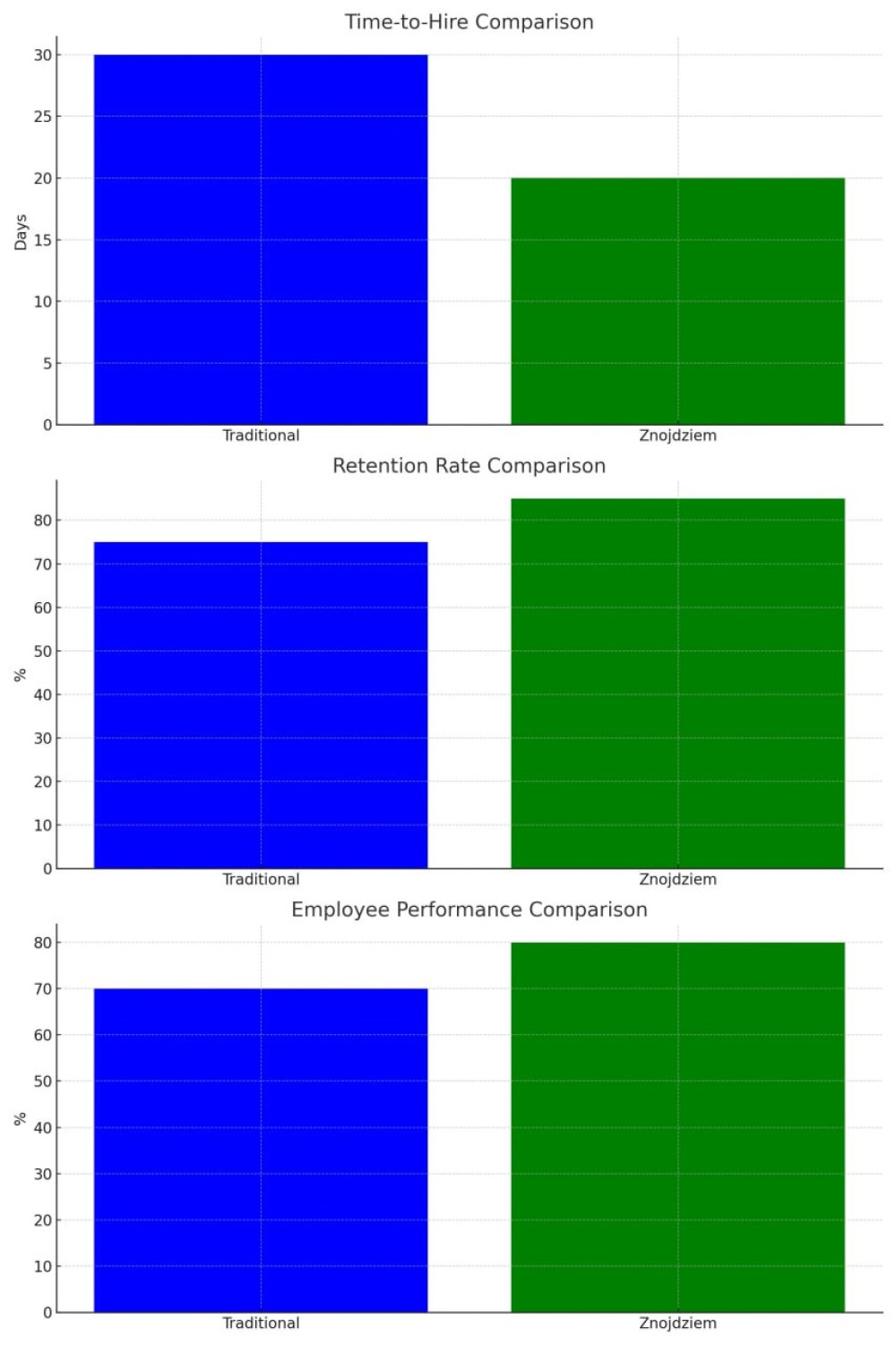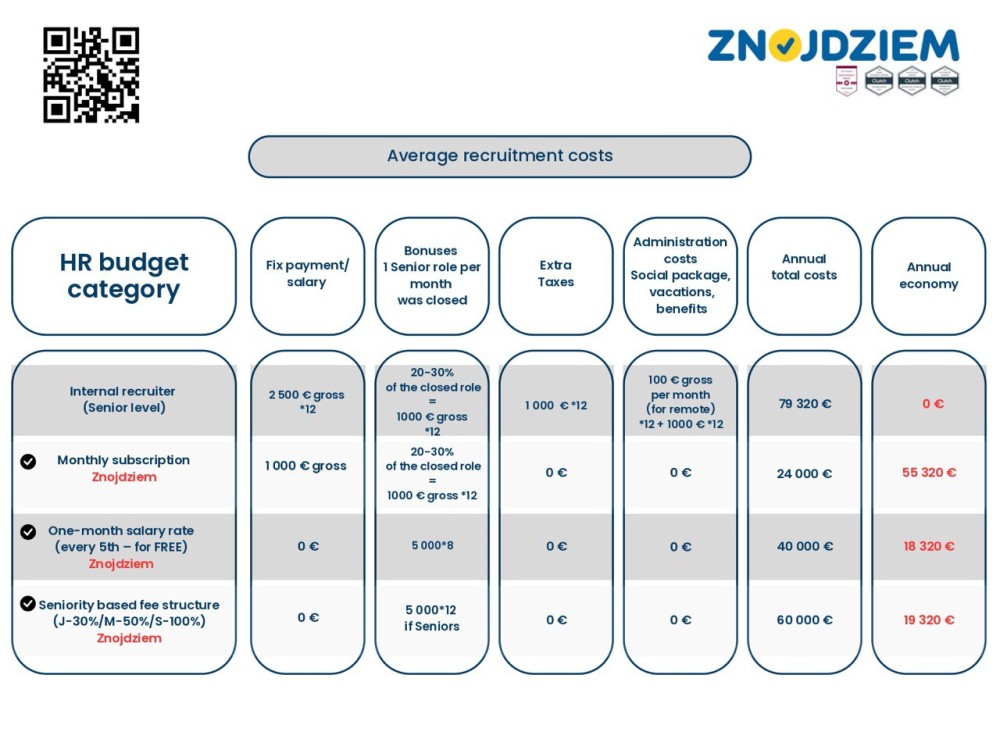The Role of ROI in Recruiting
In today's IT sector, where investments are significant and the pursuit of efficiency is relentless, understanding the return on investment (ROI) of recruitment is vital. This section examines how ROI acts as a critical metric in shaping recruitment strategies and budgeting decisions. The focus here is not only on financial aspects, but also on the strategic effectiveness of recruitment processes. We'll look at how careful ROI assessments provide insight into the cost-effectiveness of these strategies, allowing companies to allocate resources where they provide the greatest benefit. This analysis is particularly relevant to the IT industry, which is characterized by high demand for skilled professionals and where the consequences of inadequate hiring are significant. In this section, we aim to provide a comprehensive understanding of ROI assessment methods in recruitment, highlighting their impact on budgeting. We'll also touch on the role our services can play in increasing your recruiting ROI.
Understanding recruitment costs
A critical step in assessing the ROI of your recruiting investment is understanding the underlying costs. In the IT industry, where competition for the best talent is intense, these costs can be significant.
Direct recruitment costs:This includes expenses such as advertising, recruiting events and recruiter salaries. For example, the salary of a senior-level internal recruiter may represent a significant portion of these costs.
Indirect recruitment costs: They are often overlooked, but they are critical. These include time spent by hiring managers on interviews, onboarding costs, training, and lost productivity during vacancy periods.
Cost of a bad hire: Hiring the wrong person can be costly, given the cost of attrition, additional recruitment, and the impact on team morale and productivity.
Statistical analysis: Using the data from the document provided, we can create a comparison graph to illustrate the difference in costs between traditional recruitment methods and Znojdziem's services. This graph will show a clear comparison of different cost elements such as fixed fees, bonuses and administrative expenses.
Economic benefits from outsourcing recruitment: Outsourcing of personnel selection can provide cost savings. By analyzing the data presented, we can quantify these savings in a statistical format.
In subsequent sections, these costs will be analyzed in more detail and compared to our recruitment agency model, using graphical representations to better understand and analyze the impact.
Assessing the return on investment in recruitment
Measuring the ROI of your recruiting investment involves more than just comparing costs and benefits. It's about understanding the value of every hiring decision. This section discusses methodologies for calculating and interpreting ROI in the context of recruitment:
Calculation method: Recruitment ROI can be calculated by comparing the cost of recruiting processes (including wages, advertising, agency fees, etc.) to the value new hires bring to the organization.
Qualitative assessments: Beyond the numbers, it is important to measure the impact of new hires on team dynamics, innovation, and overall company culture.
Long-term and short-term ROI: It is critical to distinguish between immediate results and long-term consequences. Hiring that may seem expensive at first can bring huge long-term benefits through skills, experience and public relations.
ROI Comparison Data: Here we will present a graph that compares the ROI of traditional recruiting methods and our approach, which includes various factors such as time to hire, retention rate and employee productivity.
Data-driven decision making: This section will highlight the importance of data in making informed hiring decisions and how a strategic approach to ROI can lead to more efficient budget allocation.
Here's a graphical representation comparing the ROI of traditional recruiting methods to our company's Znojdziem approach, based on factors such as time to hire, retention rate, and employee productivity.
Hiring time comparison: This graph shows the number of days it takes to hire a candidate. A shorter hiring period is generally considered more efficient, and here our approach takes fewer days compared to traditional methods.
Retention rate comparison: This graph compares the percentage of employees who stay with a company over a given period. Higher retention rates are usually better, indicating a more successful hire. Our company's approach shows higher retention rates.
Employee performance comparison.
This graph illustrates the productivity of employees hired through various methods, measured as a percentage. The higher the productivity, the better, and the employees we hire work better.
These graphs provide a visual comparison of key ROI factors, showing that the Znojdziem approach can be more effective in certain areas compared to traditional recruiting methods.
This section discusses our unique approach to recruiting and how it differs from traditional methods:
Service model: an overview of how our recruitment services work, with a focus on their innovative strategies and tools.
Economic efficiency:A detailed study of the economic benefits of using our services. This will include comparisons with traditional recruitment methods, showing potential savings in various areas such as fixed benefits, bonuses and administrative costs.
Quality of hire: Focusing on how we improve candidate quality, leading to increased long-term ROI. This may include selection processes, assessment tools and matching algorithms.

Example: Cost-Benefit Analysis
In this section, we will conduct a detailed cost-benefit analysis using the data provided about staffing services compared to traditional staffing methods.
Graphic representation: presentation of a graph illustrating the comparative costs of using Znojdziem's services and the costs of an internal top-level recruiter. This visual aid will highlight potential budget savings.
Increased efficiency: Znojdziem's approach not only reduces costs, but also increases the efficiency of the recruitment process, resulting in reduced time to hire and improved quality of candidates.
Real consequences: Savings and efficiencies in a real-life context, demonstrating how businesses can reinvest those savings in other strategic areas.
Making strategic decisions based on ROI.
The ultimate analysis of recruiting ROI leads to strategic decisions that are critical for companies looking to optimize their recruiting budgets.
Informed budget allocation:A clear understanding of the ROI of recruiting investments helps companies allocate their budgets more effectively, ensuring that every dollar spent produces tangible benefits.
ROI-Focused Recruiting Strategies
How companies can use ROI data to improve their recruiting strategies, focusing on methods that generate the most return.
Long-term planning:Emphasizes the importance of considering long-term ROI when making hiring decisions, rather than just immediate cost savings.
The goal is to provide companies with actionable information to enable them to make more informed and strategic decisions in their recruitment processes using the power of ROI analysis.
Conclusion: The Future of Recruitment Budgeting and ROI
In conclusion, in this article we have covered the critical aspects of measuring ROI in the recruitment industry. We examined the various costs associated with recruiting, analyzed our company's unique approach, and provided a detailed case study demonstrating the potential savings and efficiencies. The Strategic Decision Making section emphasized the importance of ROI-focused hiring strategies.
The future of recruitment budgeting is a more analytical approach focused on ROI. As companies continue to face challenges in finding the right talent, especially in dynamic sectors such as IT, the ability to quantify the value of recruitment strategies will be invaluable. Organizations that adopt this approach will not only optimize their recruiting budgets, but will also gain a competitive advantage in attracting the best talent.
Ultimately, the goal of this article is to provide readers with the knowledge and tools to make informed decisions that align recruiting strategies with business goals, delivering greater ROI and contributing to the overall success of their organizations.


